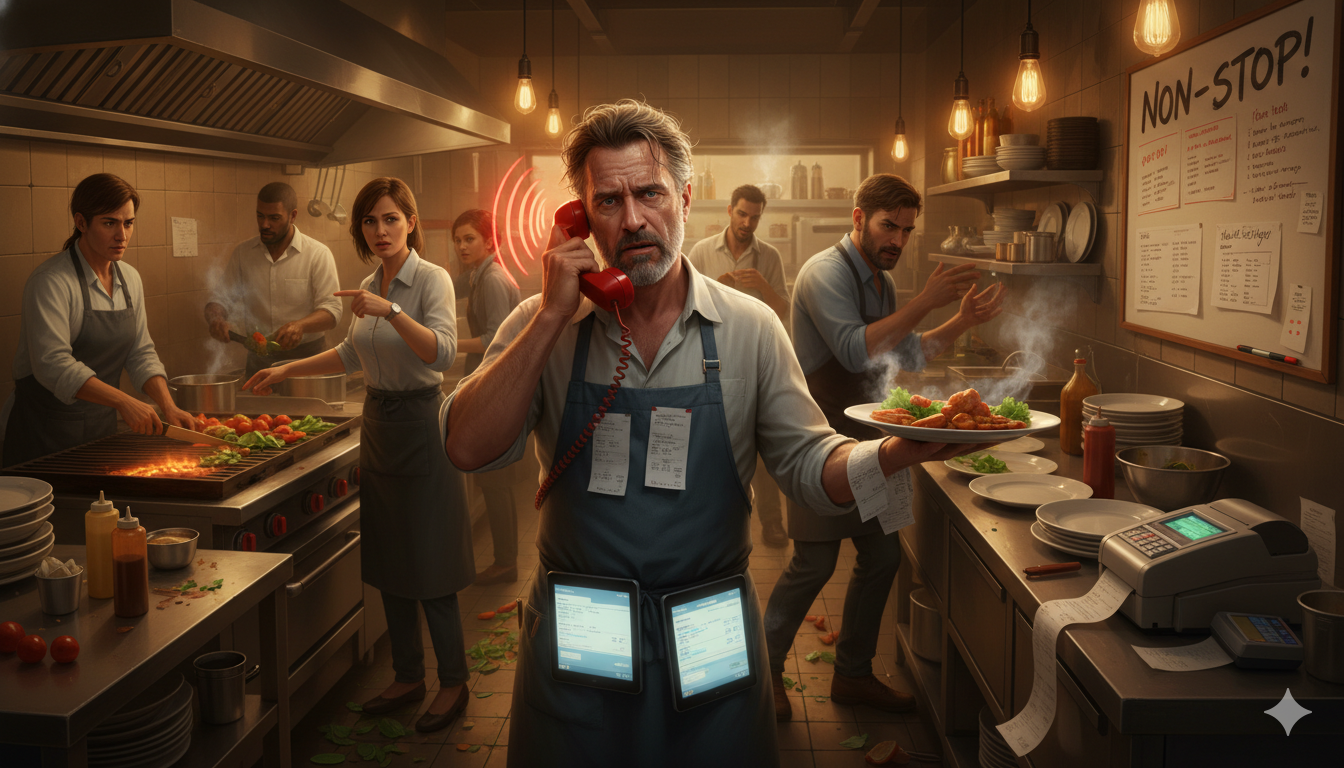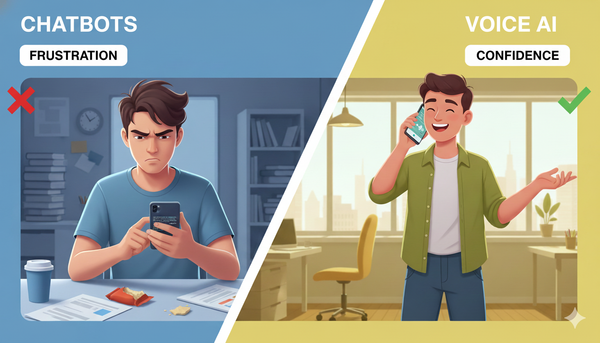AI Phone System for Restaurants: Never Miss a Reservation Again

Your restaurant is losing money every time the phone rings during dinner rush.
I'm not talking about a few dollars here and there. I'm talking about $27,000 to $292,000 a year in missed orders, lost reservations, and customers who never come back.
Here's the brutal truth: the average restaurant receives 187 phone calls every day. 43% of those calls go unanswered. And 69% of people who can't reach you? They just order from somewhere else.
This isn't a problem you can ignore. But it's also not something you can fix by hiring more staff (who has the budget for that?). The solution is simpler than you think, and I'm going to walk you through exactly how it works.
The Problem: Your Staff Can't Answer the Phone (And It's Not Their Fault)
Let's be real about what happens during a typical dinner rush.
Your host is seating a party of six. Your server is taking an order at table 12. The expo is calling out tickets. And the phone is ringing. Again.
Someone grabs it, puts the caller on hold, and... forgets about them. Or worse, no one picks up at all because everyone's buried.
The caller waits 90 seconds (that's the average), gets frustrated, and hangs up. They ordered from your competitor down the street, who answered on the first ring.
Here's what the data shows:
- 85% of people won't call back if you don't answer
- 30% of diners won't return to a restaurant that didn't answer their call
- You're losing 13% of your potential revenue just from mishandled phone calls
And it's not just about dinner rush. What about after-hours? Sundays when you're closed, but people are planning their week? Late-night cravings at 11 PM?
Every missed call is a missed opportunity. Period.
How AI Phone Systems Actually Work (It's Not What You Think)

When most people hear "AI phone system," they imagine some robotic voice that frustrates customers. That's not what we're talking about in 2025.
Modern voice AI sounds completely natural. Your customers hear a friendly voice that takes their order, books their reservation, answers menu questions, and even handles special requests. Most people don't even realize they're talking to AI (and honestly, they don't care as long as their order gets taken).
Here's how it works for restaurants specifically:
1. The AI answers every call instantly
No hold music. No "can you hold please?" Just an immediate answer, even if you're getting 10 calls at once.
2. It handles the most common requests automatically
- Taking takeout and delivery orders
- Booking reservations and checking availability
- Answering menu questions ("Do you have gluten-free options?")
- Providing hours, location, and parking info
- Handling catering inquiries
3. It knows when to transfer to a human
Complex situations, complaints, or special requests? The AI transfers the call to your staff immediately with full context of what the customer needs.
4. Everything syncs to your systems
Orders go straight to your POS. Reservations sync with your booking system. You're not managing another tool; it just works with what you already use.
The key difference from a traditional phone system: AI can handle 10 simultaneous calls during dinner rush. Your single host station? Can't do that.
Real Results: What Restaurant Owners Are Seeing
Let me give you some actual numbers from restaurants using AI phone systems:
Mid-sized Italian restaurant in Chicago:
- Was missing 65-85 calls per week
- Lost revenue: approximately $28,000/year
- After AI: 87% reduction in missed calls
- Recovered revenue: $24,000+ in first year
- ROI: 180x their monthly cost
Fast-casual chain (3 locations):
- 187 calls per day average across locations
- During peak hours, 8-10 simultaneous calls
- AI handles all overflow automatically
- Result: $47,000 annual savings vs hiring additional phone staff
Family-owned pizza shop:
- Biggest problem: after-hours calls (30% of total call volume)
- Solution: AI takes orders 24/7, even when closed
- Result: 22% increase in takeout orders from capturing late-night and Sunday calls
The common thread? These aren't massive chains with huge budgets. They're 1-3 location restaurants that couldn't afford to hire dedicated phone staff but couldn't afford to keep missing calls either.
Setup Guide: Getting Started Takes 3 Minutes (Seriously)

I know what you're thinking: "This sounds complicated and expensive to set up."
It's not. Here's the actual process:
Step 1: Tell the AI about your restaurant (2 minutes)
You answer a few questions:
- What's on your menu?
- What are your hours?
- Do you take reservations? What's your booking system?
- Any specials or promotions running?
That's it. No coding. No technical knowledge needed.
Step 2: Pick a voice (30 seconds)
Choose from different voice options. Want a warm, friendly tone? Professional? Casual? You pick what matches your vibe.
Step 3: Connect your phone number (30 seconds)
Either forward your existing number to the AI or get a new number. Takes one click.
You're live. The AI starts answering calls immediately.
Want to update your menu? Add a new special? Change your hours? You just type it in. Takes 10 seconds. No waiting for IT support or calling your provider.
The whole setup process is faster than training a new host. And unlike a new employee, the AI doesn't forget your menu, call in sick, or need breaks.
Pricing: What It Actually Costs (And Why It Pays for Itself Immediately)
Let's talk money. Because you're running a business, and you need this to make financial sense.
Klariqo pricing for restaurants:
- Phone AI: $129/month
- Includes 500 minutes (that's roughly 150-200 calls)
- Overage: $0.15 per additional minute
What does that get you?
- Answers every call 24/7
- Takes orders, books reservations, answers questions
- Integrates with your POS and booking systems
- No setup fees, no contracts, cancel anytime
Let's do the math:
Remember that $27,000/year you're losing from missed calls? That's the conservative estimate.
If the AI captures just 10 additional orders per week at your average ticket of $35, that's:
- 10 orders x $35 = $350/week
- $350 x 52 weeks = $18,200/year
Your cost: $129 x 12 months = $1,548/year
That's a 1,076% ROI. And we're only counting 10 extra orders a week. You're probably missing way more than that.
Compare to alternatives:
- Hiring a part-time phone person: $15/hour x 20 hours/week = $15,600/year (and they can't answer when they're not working)
- Traditional answering service: $200-500/month (and they're not taking orders or managing reservations)
- Missing calls: $27,000/year (and growing)
Common Questions Restaurant Owners Ask
Q: Will my customers hate talking to AI?
Here's what actually happens: customers don't care if it's AI or human as long as their question gets answered and their order gets taken correctly. In blind tests, 80% of people couldn't tell they were talking to AI. The other 20%? They appreciate getting through instantly instead of waiting on hold.
Plus, you can always have the AI transfer to a human for complex requests. Best of both worlds.
Q: What if it gets an order wrong?
The AI repeats orders back for confirmation, just like your staff does. "I've got a large pepperoni pizza for delivery to 123 Main Street. Is that correct?" If there's any confusion, it asks clarifying questions or transfers to a human.
Error rate is actually lower than stressed-out staff during rush hour who are trying to juggle three things at once.
Q: Can it handle my specific menu/needs?
Yes. The AI learns your full menu, daily specials, modifications, allergen info, everything. It can handle questions like "Do you have vegan options?" or "Can I substitute the fries for a salad?"
It also learns over time. If customers frequently ask about a specific dish, it gets better at describing it.
Q: What about our existing phone system?
You don't need to change anything. The AI works with your current phone setup. Just forward calls to the AI number, or use it as your main line.
Q: What happens during really busy times?
This is where AI shines. During dinner rush when you're getting 8-10 simultaneous calls, the AI handles all of them at once. No busy signal. No hold times. Every caller gets through.
Q: Can I turn it off or adjust it?
Completely. You control when it's active. Want it to only handle after-hours calls? Done. Want it to take overflow when your staff is busy? Easy. Want humans to answer first and AI to be backup? You can set that up too.
Next Steps: Stop Losing $27,000 a Year
Here's the reality: every day you wait is another day of missed calls, lost orders, and customers going to your competitors.
The good news? This is one of the easiest problems to fix in your restaurant. You can be live and answering every call in less time than it takes to do tonight's prep.
Here's what to do:
- Try Klariqo free - You get 30 free minutes to test it with real calls. No credit card needed. See if it works for your restaurant.
- Set it up in 3 minutes - Answer a few questions about your menu and hours. Pick a voice. Connect your phone.
- Watch it work - See missed calls drop to zero. Watch orders roll in after-hours. Stop losing money.
If you're skeptical, I get it. Test it during your slowest day first. Forward calls for a week and see what happens. I'm confident you'll see the difference immediately.
The alternative is doing nothing and watching another $27,000 walk out the door this year.
Your choice.




